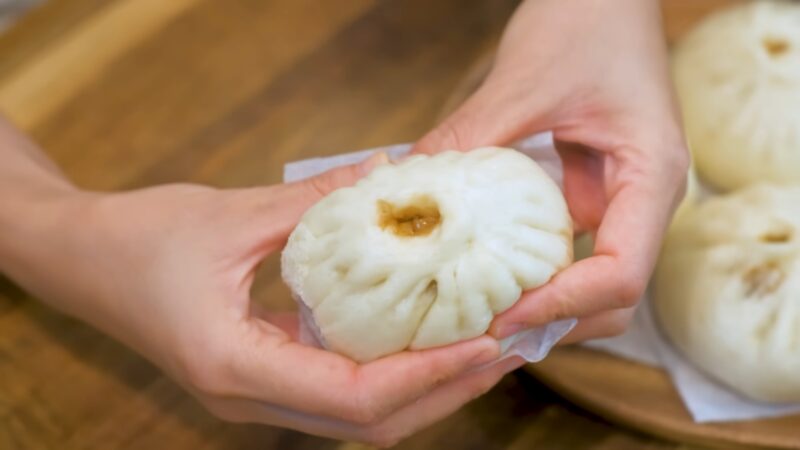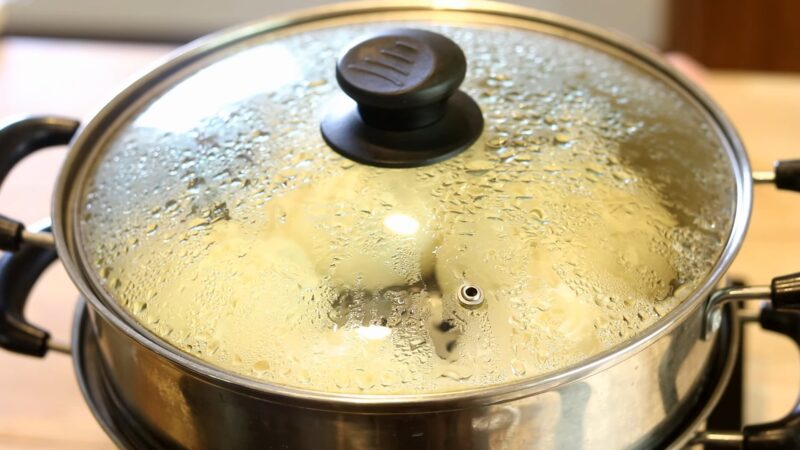Greetings, culinary aficionados! Throughout my professional journey, I’ve dedicated ample time to perfecting the skill of crafting steamed buns.
Whether in the vibrant avenues of Beijing or the tranquil nooks of my personal culinary sanctuary, I’ve been relentlessly pursuing the creation of the most flawlessly airy steamed bun. Today, I’m thrilled to present you with my comprehensive manual on steaming buns sans a traditional steamer.
In this detailed guide, we’ll explore the fascinating world of buns and the art of steaming, along with innovative techniques for steaming right in your kitchen, with no steamer needed. Whether you’re an experienced cook or a culinary novice, this guide is designed to be practical, informative, and accessible.
And for all the Kung Fu Panda fans out there, you’ll remember Po’s love for these delicious steamed buns. With this guide, you’ll be able to create your own steamed buns, worthy of a Dragon Warrior.
So, don your apron, channel your inner Po, and let’s delve into the exciting world of steaming buns without a steamer!
The Diversity

Buns, in their myriad forms, are a global phenomenon, but it’s in Asia where this art truly shines. Steamed ones, or ‘baozi’ as they’re known in China, are a beloved staple in many Asian cuisines.
Unlike their baked counterparts found in Western cuisines, such as the rich, buttery brioche in the United States or the robust, chewy pretzel in Germany, Asian ‘baozi’ are often steamed to perfection, resulting in a delightfully soft and fluffy texture.
This unique texture makes them an ideal vessel for a wide array of fillings, from sweet to savory, creating a versatile treat that can be enjoyed at any time of day. The world of Asian buns is vast and diverse, with each region offering its own unique spin.
From the classic Chinese ‘baozi’, filled with succulent pork or sweet bean paste, to the delicate, translucent har gow of dim sum fame, the variety is truly astounding. Each type of bun carries with it a rich history and a unique blend of flavors and textures, making the exploration of Asian steamed buns a culinary adventure in its own right.
Sweet Baozi
Sweet buns are a delightful treat that can be enjoyed at any time of day. They can be filled with a variety of sweet fillings, such as custard, fruit jam, or sweetened red bean paste.
The most popular type is filled with Chinese custard. When steaming them, you can add a bit of sugar to the dough to give it a subtle sweetness that complements the filling.
Savory ‘Baozi’
Savory buns are perfect for a hearty meal or snack. They can be filled with a variety of savory fillings, such as meat, vegetables, or mushrooms.
Some popular types of savory buns include Char Siu Bao, Char Siu Bao, and Bao Bun With Pickled Red Onion. When steaming them, you can add herbs or spices to the dough to enhance the flavor of the filling.
Gluten-Free ‘Baozi’
For those with dietary restrictions, gluten-free buns are a great option. They can be made with a variety of gluten-free flour, such as rice flour, almond flour, or coconut flour.
The process of making gluten-free ‘baozi’ is a bit different from making regular ones, as gluten-free dough can be more difficult to work with. However, with a bit of practice, you can make delicious, fluffy gluten-free buns that everyone can enjoy.
The Art of Steaming
Steaming buns results in a unique texture that’s light, fluffy, and moist. This method is commonly used in Asian cuisines, particularly for baozi or mantou in China, and nikuman in Japan.
However, you don’t need to limit yourself to these traditional recipes. The steaming technique can be applied to any type of bun, opening up a world of culinary possibilities. The key is to understand the process and the principles behind it.
Once you’ve mastered the basics, you can start experimenting with different types of dough and fillings to create your own unique steamed buns.
The Basics of Steaming
Why Steam?
Steaming buns, instead of baking them, can yield a completely different texture and flavor. The steam cooks them evenly and gently, resulting in a soft, moist, and fluffy texture that’s perfect for soaking up sauces or fillings.
Plus, steaming is a healthier cooking method, as it doesn’t require any oil or fat. It’s also a great way to reheat leftover buns without drying them out. Steaming is also a more forgiving method than baking, making it a great option for beginner bakers.
The Traditional Steaming Method

Traditionally, buns are steamed in a bamboo steamer, which allows the steam to circulate freely, cooking them evenly. The bamboo also absorbs any excess moisture, preventing them from becoming soggy.
However, not everyone has a bamboo steamer at home. But don’t worry, there are plenty of alternative methods you can use. The key is to create a setup that allows steam to circulate around the buns.
This could be as simple as using a pot and a colander, or as creative as rigging up a makeshift steamer with a plate and some aluminum foil.
The Importance of Steam

Regardless of the method you choose, the key to steaming buns is to generate enough steam. This is what cooks them and gives them their characteristic fluffy texture.
It’s also important to ensure the steam circulates evenly, so all parts of the bun cook at the same rate. Too little steam can result in dry, tough buns, while too much can make them soggy.
It’s also important to keep the heat at a steady level. If the heat is too high, the buns might cook too quickly on the outside and remain raw on the inside. If it’s too low, they might not rise properly.
Steaming Without a Steamer
Using a Pot and a Colander

One of the simplest ways to steam buns without a steamer is to use a pot and a colander. Here’s how:
- Fill a pot with about an inch of water and bring it to a boil.
- Place them in a colander, making sure they don’t touch the water.
- Cover the pot and let them steam for about 15 minutes.
This method is great because it uses items that most people already have in their kitchens. The colander acts as a steamer basket, allowing the steam to circulate around the buns. Just make sure the colander is large enough to hold them without crowding them.
Using a Plate and Aluminum Foil
Another method involves using a plate and aluminum foil. Here’s the process:
- Crumple some aluminum foil into balls and place them in a pot.
- Pour in enough water just below the top of the foil balls.
- Place a heatproof plate on top of the foil balls, then place the buns on the plate.
- Cover the pot and steam them for about 15 minutes.
This method is a bit more makeshift, but it works surprisingly well. The foil balls elevate the plate above the water, allowing the steam to circulate around the buns. Just make sure the plate is large enough to hold them without crowding them.
Using a Microwave
If you’re really in a pinch, you can even steam buns in the microwave. Here’s how:
- Place them on a microwave-safe plate.
- Fill a microwave-safe bowl with water and place it next to the plate.
- Microwave the buns on high for about 15 seconds, then let them rest for 10 seconds.
- Repeat this process until they are fully cooked.
This method is quick and easy, but it can be a bit tricky to get the timing right. It’s best used for reheating buns rather than cooking them from scratch. Also, keep in mind that microwaved ones may not be as fluffy as those steamed on the stovetop.
Tips for Perfect Steaming
Preparing
Before you start steaming, there are a few things you should do to prepare your buns:
- Make sure the buns are at room temperature before you start steaming. If they’re too cold, they might not cook evenly.
- If you’re using frozen ones, let them thaw completely before steaming.
- Don’t overcrowd them. They need space to expand as they cook.
- If you’re making your own buns, let the dough rise properly before shaping and steaming them.
During the Steaming Process
While your buns are steaming, keep these tips in mind:
- Don’t lift the lid too often. This lets out the steam and can result in uneven cooking.
- If you’re steaming multiple batches of buns, be sure to replenish the water in the pot as needed.
- Keep an eye on the heat. If the water starts to boil too vigorously, turn down the heat.
After Steaming

Once your buns are done steaming, follow these steps:
- Let them rest for a few minutes before removing them from the pot. This allows the steam to dissipate and prevents you from getting burned.
- Serve the buns while they’re still warm. They’re best enjoyed fresh out of the steamer!
- If you have any leftovers, store them in an airtight container. They can be reheated in a steamer or microwave.
Conclusion
Steaming buns without a steamer might seem daunting, but with these tips and techniques, you’ll be able to enjoy perfectly steamed buns at home, no matter what equipment you have on hand. So why not give it a try?
You might just discover a new favorite cooking method! And remember, the best part about cooking is experimenting and making the process your own.
So don’t be afraid to try different types of dough, fillings, and steaming methods. Happy steaming!

